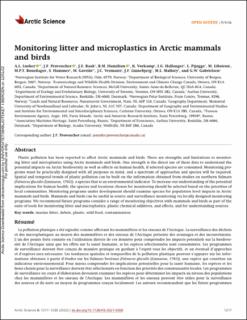| dc.contributor.author | Lusher, Amy | |
| dc.contributor.author | Provencher, Jennifer F. | |
| dc.contributor.author | Baak, Julia E. | |
| dc.contributor.author | Hamilton, Bonnie M. | |
| dc.contributor.author | Vorkamp, Katrin | |
| dc.contributor.author | Hallanger, Ingeborg G. | |
| dc.contributor.author | Pijogge, Liz | |
| dc.contributor.author | Liboiron, Max | |
| dc.contributor.author | Bourdages, Madelaine | |
| dc.contributor.author | Hammer, Sjúrður | |
| dc.contributor.author | Gavrilo, Maria | |
| dc.contributor.author | Vermaire, Jesse | |
| dc.contributor.author | Linnebjerg, Jannie F. | |
| dc.contributor.author | Mallory, Mark L. | |
| dc.contributor.author | Gabrielsen, Geir W. | |
| dc.date.accessioned | 2023-03-23T11:33:00Z | |
| dc.date.available | 2023-03-23T11:33:00Z | |
| dc.date.created | 2022-06-09T09:04:28Z | |
| dc.date.issued | 2022 | |
| dc.identifier.citation | Arctic Science. 2022, 8, 1217–1235. | en_US |
| dc.identifier.issn | 2368-7460 | |
| dc.identifier.uri | https://hdl.handle.net/11250/3060093 | |
| dc.description.abstract | Plastic pollution has been reported to affect Arctic mammals and birds. There are strengths and limitations to monitoring litter and microplastics using Arctic mammals and birds. One strength is the direct use of these data to understand the potential impacts on Arctic biodiversity as well as effects on human health, if selected species are consumed. Monitoring programs must be practically designed with all purposes in mind, and a spectrum of approaches and species will be required. Spatial and temporal trends of plastic pollution can be built on the information obtained from studies on northern fulmars (Fulmarus glacialis), a species that is an environmental indicator. To increase our understanding of the potential implications for human health, the species and locations chosen for monitoring should be selected based on the priorities of local communities. Monitoring programs under development should examine species for population level impacts in Arctic mammals and birds. Mammals and birds can be useful in source and surveillance monitoring via locally designed monitoring programs. We recommend future programs consider a range of monitoring objectives with mammals and birds as part of the suite of tools for monitoring litter and microplastics, plastic chemical additives and effects, and for understanding sources. | en_US |
| dc.language.iso | eng | en_US |
| dc.publisher | Canadian Science Publishing | en_US |
| dc.rights | Navngivelse 4.0 Internasjonal | * |
| dc.rights.uri | http://creativecommons.org/licenses/by/4.0/deed.no | * |
| dc.subject | Miljøgifter i Arktis | en_US |
| dc.subject | Environmental pollutants in the Arctic | en_US |
| dc.subject | Forurensing | en_US |
| dc.subject | Pollution | en_US |
| dc.subject | Mikroplast | en_US |
| dc.subject | Microplastic | en_US |
| dc.title | Monitoring litter and microplastics in Arctic mammals and bird | en_US |
| dc.type | Peer reviewed | en_US |
| dc.type | Journal article | en_US |
| dc.description.version | publishedVersion | en_US |
| dc.rights.holder | © 2022 Authors | en_US |
| dc.subject.nsi | VDP::Zoologiske og botaniske fag: 480 | en_US |
| dc.subject.nsi | VDP::Zoology and botany: 480 | en_US |
| dc.subject.nsi | VDP::Zoologiske og botaniske fag: 480 | en_US |
| dc.subject.nsi | VDP::Zoology and botany: 480 | en_US |
| dc.source.pagenumber | 19 | en_US |
| dc.source.journal | Arctic Science | en_US |
| dc.identifier.doi | 10.1139/AS-2021-0058 | |
| dc.identifier.cristin | 2030366 | |
| dc.relation.project | EC/H2020/101003805 | en_US |
| dc.relation.project | Andre: Norsk Polarinstitutt | en_US |
| cristin.ispublished | true | |
| cristin.fulltext | original | |
| cristin.qualitycode | 1 | |

